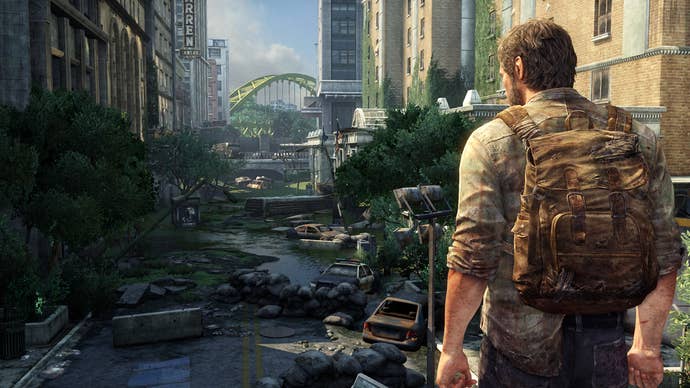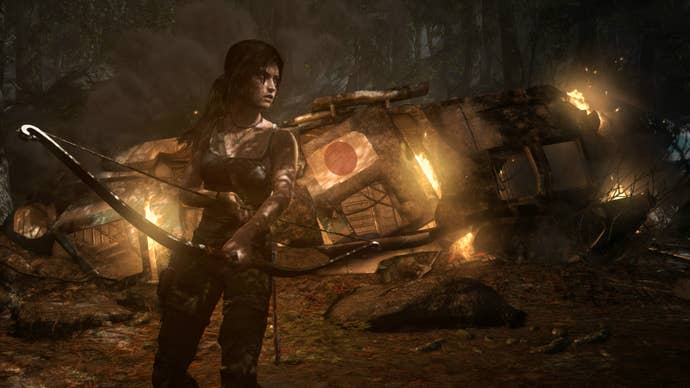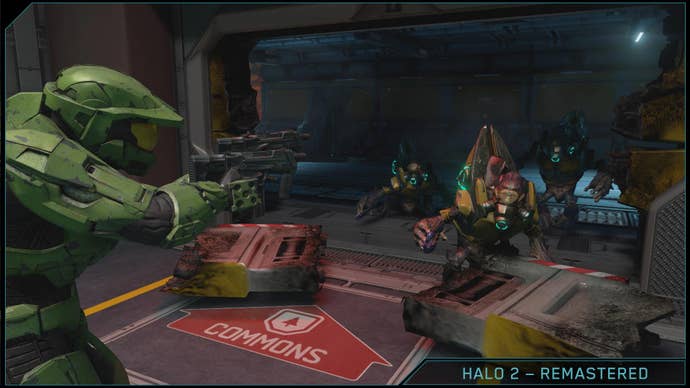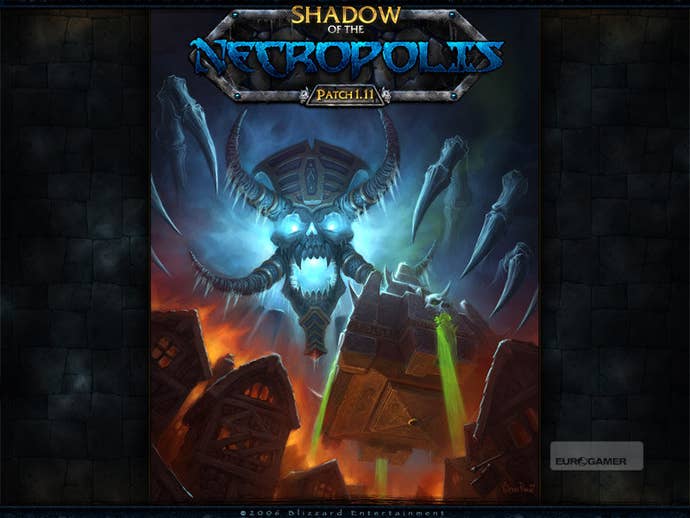The Art of the HD Remaster
A number of developers are revisiting past works with HD remasters, but the process of bringing an old game to a new platform is anything but easy.
This article first appeared on USgamer, a partner publication of VG247. Some content, such as this article, has been migrated to VG247 for posterity after USgamer's closure - but it has not been edited or further vetted by the VG247 team.
Heading into the holiday season, it feels like half of the games coming out on PlayStation 4 and Xbox One are remastered titles. We've already had Tomb Raider: Definitive Edition and The Last of Us: Remastered, and there's still Grand Theft Auto V, Halo: The Master Chief Collection, Sleeping Dogs: Definitive Edition, Metro Redux, Final Fantasy Type-0 HD, Kingdom Hearts 2.5, Resident Evil HD Remaster, and new versions of Journey and Unfinished Swan. That's just on the immediate horizon.
The general belief is that HD remaster process is easy, especially for titles that released on PC or towards the end of the previous generation. Consumers think that it takes a bit of coding, a quick polish of art assets, and then a speedy release. In reality, porting a game over to another platform is a process that's more art than science. Assassin's Creed's PC ports have been fraught with problems due to poor optimization and I just finished reviewing Dead Rising 3 for PC, which had similar issues.

I reached out to the developers behind some of the recent and upcoming HD remasters to understand the process. The Last of Us: Remastered designer Anthony Newman and Crystal Dynamics executive producer Scot Amos were willing to talk about remaster development and how their respective studios handled the process.
A great HD remaster requires bringing the original game to a new platform, utilizing that new platform's abilities to the fullest. It's not just about the technical aspect; you also have to manage fan expectations. This means better character models, more environmental effects, improved resolution, and addition of small features like improved foliage, weather, or water. Great HD remasters allow fans to revisit some amazing games on their shiny new consoles, but they also allow new consumers to play many of these games for the first time. If you missed Tomb Raider on PlayStation 3 and Xbox 360, Tomb Raider: Definitive Edition is your window into the franchise. Getting the game onto that new platform takes time.
"I've had the privilege of making games on almost every platform of one flavor or another – some original, some ports, and there's never anything easy about changing a game that's been honed to exist and show off one platform to custom-fitting it to another," says Crystal Dynamics' Amos. "From controllers, to specific features, to platform holder requirements, to fans' expectations; all of these factors must be taken into consideration as we're delivering an experience and it has to be great no matter what platform it's on. Having a multi-studio, global team effort is what it takes to make a great experience and we're lucky we have that privilege."
"I think the thing consumers don't understand about the remaster process is that it really isn't easy," says Naughty Dog's Newman. "We actually worked very, very hard to get the remaster out the door. The Last of Us is an unthinkably complicated game: we had people losing sleep on issues as diverse as water refraction and on what part of the frame to deal melee damage. That said, I'm really proud of all the work the team put in, and as someone who loves TLOU, I'm so glad to be able to play the remaster: it's definitely the way the game was meant to be played."

Most remasters focus first on the technical aspect, trying to hit what many enthusiasts perceive as the standard: 1080p resolution at 60 frames per second (fps). With that as a starting point, developers then attempt to optimize their game so the experience comes across well. The team at Naughty Dog aimed for the aforementioned standard, while the Tomb Raider: Definitive Edition team locked their framerate at 30 fps minimum.
"The resolution and framerate question were both pretty easy: most televisions can display a maximum of 1080p natively, so, if we were going to increase our resolution, this seemed like the natural target," explains Newman. "In terms of framerate, 60 fps felt like the sweet spot to give the game that 'fluid' feel without getting excessive."
"With the coming of Xbox One and PS4, getting to a native 1080p resolution at a minimum 30 frames per second was always a requirement we put on ourselves; anything beyond that was considered gravy. But having that truly HiDef, smooth-controlling, great user experience is the must-have for us to ship it," says Amos.
There's also the decision to use console-specific features that weren't available in the last generation. On the PlayStation 4, this means the lightbar, touchpad and controller speaker, while the primary Xbox One offering is the all-new Kinect. Frequently, the Dual Shock 4's touch pad is used to mimic the use of mouse or touchscreen, handling maps and menus.

"We wanted to add just a few judicious touches to make sure the remaster felt distinctly like a PS4 game," adds Newman. "Adding the flashlight sound to the controller speaker, or turning the lightbar red when the player is low on health are a couple of touches that we felt would take advantage of the new features of the PS4 without compromising the original experience."
Amos explains that prototyping new features was key for Crystal Dynamics' work on Tomb Raider: Definitive Edition. The studio started with understanding the available features on each console, then determining how those features could be used to improve the Tomb Raider 2013 experience. The team at Crystal Dynamics also had a list of concepts and ideas that couldn't fit into the 2013 edition, so part of the development process for Definitive Edition involved revisiting that list.
Developing an HD remaster takes hard work and development effort, but it's different from creating a game from scratch. In the case of a remaster, the design and narrative work is already done. All that remains is moving the core game over to the new platform and seeing what additional work can be done with the gulf in console power. That's still a tall order.
"Every project, of any type, scale, or size will have a variety of challenges to face," says Amos. "Shipping any game, whether it's a new franchise trying to get noticed or an existing classic with huge fan expectations – it's never easy. That said, having an award-winning foundation up front is definitely a supreme advantage compared to starting with a blank canvas and having to identify where the edges are. The difference comes in when you have to meet - and where possible, exceed - the fans' expectations.

If the remaster process isn't easy, wouldn't a developer's time be better spent working on all-new content, instead of revisiting the glory days? Amos declines to say how large the Tomb Raider: Definitive Edition team was, but he says that the team was comprised of "a core Crystal Dynamics group" with help from Sleeping Dogs developer United Front Games and porting studio Nixxes Software. This allowed the rest of Crystal Dynamics to continue work on other titles, like Tomb Raider 2013 sequel Rise of the Tomb Raider. For that core team and their partners, work on the Definitive Edition was a new frontier."
"With new hardware comes new unknowns. Remember, we were out within a few months of the hardware launch, so we were bleeding edge on things like the controllers, the latest features, optimizing for the processors, making our engine run its best on new hardware, learning by experimenting on how to put in new materials, particle effects, our TressFX hair solution, etc. All of these things are reinventions for a new platform that none of us had ever shipped on before so we had to learn as we went!" says Amos.
According to Newman, Naughty Dog's work on The Last of Us Remastered was the work of a small group "mostly comprised of our programming team" that worked on the project for a year to a year-and-a-half.
"It's tough to compare the remaster to the difficulty of creating a full release because you really don't have to worry too much about content: the main design and assets are all already there," explains Newman. "Really, the brunt of the challenge fell to our amazing programmers. The greatest difficulty here was adapting the Naughty Dog engine to the wholly different architecture of the PlayStation 4. Our code was filled with arcane and extremely complex optimizations to get every last ounce of power out of the PlayStation 3's SPUs. I say the greatest challenge of the remaster was coming up with totally new insanely complex optimizations...and then fixing all the bugs!"

That work is beneficial for remaster teams - even outside of sales - because they can take that expertise forward into a new title. The remaster work gives a developer the chance to play around with the new platforms. Think of it as training wheels for new console development.
"Developers are still grappling with the difficulties of adapting to the next generation of consoles and some remasters serve as a nice 'bridge': a way to get one's feet wet on the next gen without also dealing with the difficulties of creating an entirely new game," says Newman. "I think, sometimes, remasters serve well for certain studios, but I can only speak for the game that I worked on. I personally love a well-done remaster; there are so many games from last gen that I think would really sing on the PS4."
For Amos, these remasters are no different than watching film or television remasters on DVD or Blu-Ray. It's about what the fans want and the studio has time to provide.
"I've watched some favorite movies on older formats such as VHS; and I've watched those same movies on Blu-Ray or Hi-Def downloads... and seeing is believing," Amos admits. "As an indicator, since Tomb Raider: Definitive Edition's release, there are several other franchises following suit. As a consumer, I always want the ultimate experience to immerse myself into whatever game world I'm escaping into for the night. As long as we can deliver players better and richer experiences, I have no doubt we as an industry will create Definitive Editions which make sense for fans."

That's not to say we're going to continue seeing as many HD remasters as we've seen this year and planned for 2015. As this console generation matures, developers will have a firm understanding on the PlayStation 4 and Xbox One, meaning one of the benefits of remastering is lessened. Even platform holders realize that relying on remasters too often sends the wrong message about the $400+ consoles many consumers just purchased.
"You can't have too many of these things otherwise next-gen just looks like rehashed last-gen and we certainly don't want that," Sony Computer Entertainment Europe boss Jim Ryan told CVG last month. "I think the balance is just about right but you know, there are other games that could be looked at, but there'll come a point where next-gen will have moved on and rehashing old-gen will have passed its sell-by date."
For a developer with a great existing canvas, the HD remaster is a chance to improve upon the original product and move closer to the ideal vision. Every game is a series of compromises, an ongoing effort to fit the combined vision of hundreds or people into the confines of specific technology. The remaster is a developer saying, "This is what I wanted you to see" to returning fans and newcomers.
"Devs love going back to a game they all poured heart and soul into once in order to further realize that vision with Definitive Edition touches and upgrades," says Amos. "That coupled with fans enjoying those visual storytelling details, the added depth to the overall feeling of an epic origin tale, and the ability to more richly-immerse one's self into that world is why we did this."

